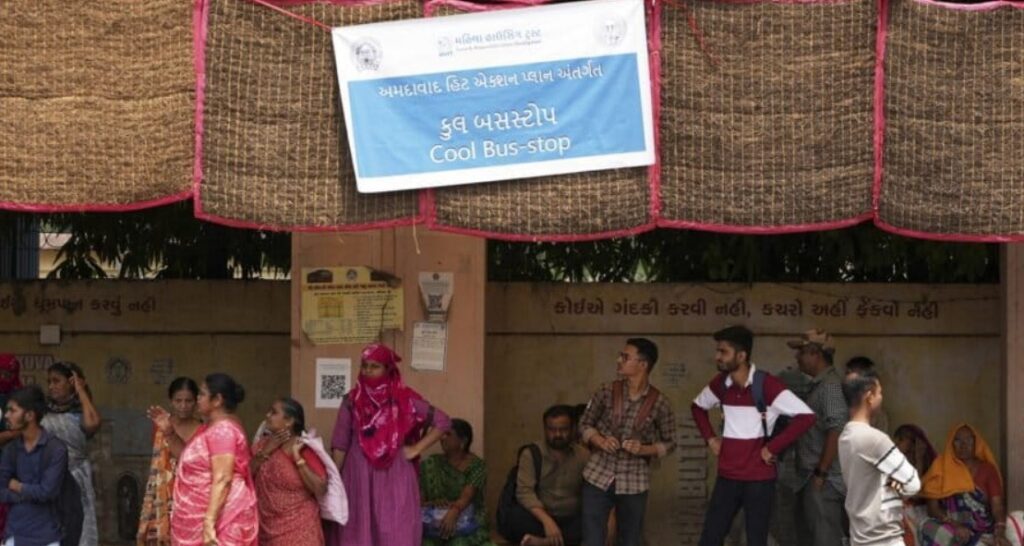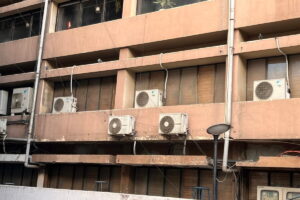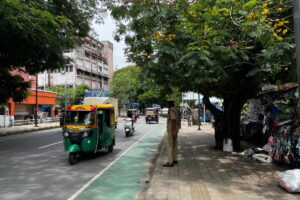Building Cooler Cities That Reduce Inequalities
Oct 21, 2025 | Pratirodh Bureau
A cool bus stop in Ahmedabad, Gujarat (AP Photo/Ajit Solanki)
- People living in informal settlements and outdoor workers experience heat impacts far more severely than others.
- Heat Action Plans must account for the lived experiences of the people, and incorporate gender and labour rights into the frameworks. They should look beyond short-lived cooling solutions.
- To have livable cooler cities, civil society organisations, urban planners, local governments, and funders must work together to embed heat resilience into everyday infrastructure.
Exceptionally hot days in Indian cities are no longer exceptional. They are becoming more common with each passing year. Rapid urbanisation, the removal of green spaces, and the spread of concrete surfaces are trapping heat and contributing to what researchers describe as the Urban Heat Island (UHI) effect.
This leaves people with no option but to resort to instant cooling mechanisms such as air conditioning, which are neither inclusive nor sustainable. They strain energy resources, drain our wallets, and, in trying to cool our homes, end up making our cities hotter, trapping us in a vicious cycle. We must imagine a way out.
Heat waves, inequality, and the case for rethinking how cities are built
Till now, cities have grown with the sole aim of accommodating a rising population. As a result, the natural geographical fabric has been disregarded in the process of urban development. The flooding in Bengaluru this year and the water scarcity in New Delhi’s informal settlements almost every summer, are direct results of unplanned urban growth. Extreme heat is also a consequence of the same problem.

To add to that, cities are also sites of deep inequality. People from underprivileged communities, especially those living in informal settlements and working outdoors during peak hours, experience the impacts of extreme heat far more severely. So, as it works currently, those who can afford air conditioners are able to forget about the growing heat outside their homes and offices, meanwhile others are left to constantly bear its brunt.
Heat, unlike other major climatic events, does not come and go quickly. Instead, it seeps into people’s daily lives, causing health risks, water scarcity, food insecurity, and straining our energy resources. It also leads to mental exhaustion and reduced productivity. Therefore, our responses to extreme heat need to focus on making our cities inherently cooler and develop solutions that resonate with the lived realities of the citizens.
This means the heat solutions that we integrate in our cities should be closely designed with the communities and aligned to what they need. For example, Mahila Housing Trust introduced cost-effective heat adaptation technologies to improve thermal comfort in informal settlements. Innovations included Mod-Roofs, made from recycled materials that reduce indoor temperatures by 6-8°C and Air Lite Ventilators that enhance airflow and cooling. These housing interventions, co-created with communities, helped low-income families cope with extreme heat. They reduce energy costs, improve health, and increase productivity in heat-stressed urban areas.
Moreover, urban development should respect natural ecologies and restore green spaces within the built environment to regulate temperatures. In Kochi, Kerala, the Kawaki Initiative empowers communities to lead urban greening efforts, collaborating with the Kochi Municipal Corporation to plant and maintain trees. This initiative enhances urban greenery, reduces heat stress, and fosters climate resilience. Recognised in Kochi’s 2031 master plan, the initiative stands as an example of a scalable model for community-driven climate adaptation.
The fault in our current responses to extreme heat
India’s current Heat Action Plans (HAPs) lack local contexts and are underfunded. Although designed for the most impacted, due to their top-down approach, they do not address the nuances of gender-based and livelihood-based vulnerabilities that are unique to specific local realities.

As a result, India’s responses to heat are often short-sighted and short-lived, failing to fully address the very problem they aim to solve.
For instance, inside garment factories during the long, heatwave-affected summers of Tamil Nadu, women are subjected to extreme heat, exacerbated by machinery, dense infrastructure, and poor ventilation. Although Tamil Nadu has Heat Action Plans (HAPs), these workers are still suffering from extreme heat with no documented solutions in place.
There are no heat monitoring systems in the factories, no scheduled breaks, and women often work long hours without even access to drinking water. This, when combined with social expectations on women to cook and care for their families after returning home, contributes to severe physical and mental exhaustion.
This is not an isolated case. Hundreds of factory and construction workers, and street hawkers, who make up India’s informal workforce, continue to toil without any protection from extreme heat. When combined with poor living conditions, post-work responsibilities, and constant exposure to high temperatures, this poses serious risks to their health and productivity.
Thus, Heat Action Plans must account for the intricacies of the lived experiences of the people they aim to help. They need to incorporate gender rights, as well as worker and labour rights, into their frameworks.
In addition to ignoring the existing social disparities, the city-wide responses to extreme heat also lack policies for sustenance and long-term maintenance.
In Kolkata, air-conditioned bus stops were introduced in 2014 to provide relief to waiting commuters. However, this initiative was launched without a policy for their maintenance. A decade later, the bus stops are now non-functional and commuters are left with two uncomfortable options: standing inside enclosed, poorly ventilated structures, or waiting directly under the sun.
Similarly, in New Delhi, temporary structures have been built for night shelter dwellers to offer beds and respite from the heat. However, inhabitants have reported that the shelters lack clean drinking water and do not have enough fans, coolers, or air conditioners for the number of people lodging there.
A common pattern observed in the failure of responses is that they tend to be estranged from real-life experiences of the citizens, rely heavily on short-term solutions and are often difficult to scale due to a lack of policy and financial support.
Shifting from isolated fixes to systemic, heat-resilient solutions
For any change to last, it has to be built from the ground up, and for any change to be robust, it needs to be systemic. When community voices shape policy, and policy and funding support the community to respond to heat, we find successful heat-resilient solutions.

For example, in Mumbai’s informal settlement of Ambujwadi, residents collaborated with the NGO YUVA to conduct climate vulnerability mapping. Through participatory assessments, they identified areas prone to heat stress and flooding, leading to the development of a Community Climate Action Plan (CCAP). YUVA then submitted these findings to the relevant civic ward of the Brihanmumbai Municipal Corporation (BMC), and community leaders are now working with municipal authorities to create storm water drains and transform open spaces into green areas to build resilience to heat and flooding.
YUVA’s Community Climate Action Plan (CCAP) received crucial support from the Brihanmumbai Municipal Corporation (BMC), which strengthened the initiative and helped build strong collaboration with local communities, leading to successful implementation. Today, the CCAP has not only become a guiding document for climate policy in Mumbai but also serves as a model for other cities.
Thus, the first and the most crucial step at this point of time should be to document existing solutions, identify the challenges they face, and draw the attention of policymakers and funders to them. Solutions exist, especially community-led ones, but we need to integrate them into broader adaptation and climate policy frameworks. Without proper support, these solutions will emerge and fade without ever reaching their full potential.
Our cities are home to millions of people, each with a vastly different set of experiences. As we reimagine our cities to adapt to heat, we should use this opportunity to reduce existing inequalities. Instant and personal cooling measures are short-lived and benefit only those who can afford or access them, while contributing to overall rising temperatures.
Instead, if we build cooler cities that naturally reduce temperatures, provide shade, and are fundamentally sustainable, they will become better homes to everybody, irrespective of their socio-economic realities. To achieve this, civil society organisations, urban planners, local governments, and funders must work together to embed heat resilience into everyday infrastructure. Only then will our solutions to extreme heat be holistic, effective, and fair.
(Published under Creative Commons from Mongabay India)
